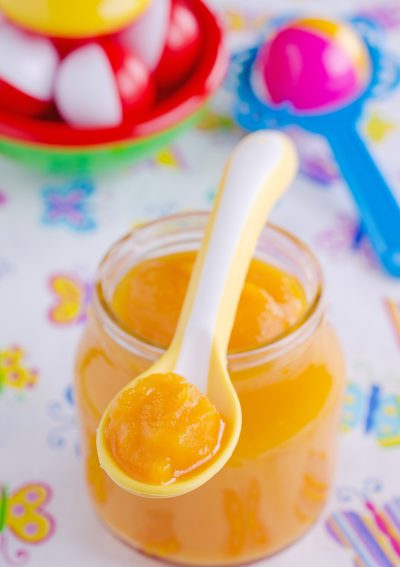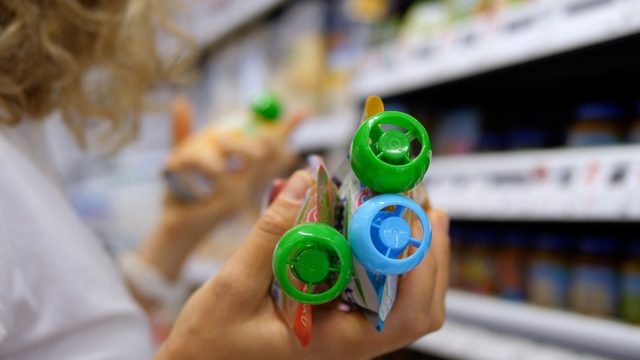Gerber Baby Food & Heavy Metals
Government and independent testing found heavy metals in Gerber baby foods. These metals are dangerous to babies because they may increase the risk of learning disabilities and disorders. Fortunately, you can help reduce your child’s risk and take legal action if your baby is adversely affected.

Why Heavy Metals Matter for Babies’ Brain Development
Heavy metals can be toxic and harm your infant’s brain development. These metals have been linked to issues with behavior, cognition and learning.
Research has found that disorders like ADHD, autism and learning disabilities may be associated with heavy metal exposure in infants and young children.
The primary heavy metals that find their way into baby food and endanger your child’s safety include arsenic, cadmium, lead and mercury.
Independent & Congressional Tests on Gerber Products
Independent and congressional testing found concerning levels of arsenic, cadmium, lead and mercury in Gerber baby foods. Sometimes, the amounts of these metals exceeded food safety limits for other food products.
2019 Healthy Babies Bright Futures Report Findings
Independent tests from advocacy group Healthy Babies Bright Futures revealed that 95% of 168 baby foods tested from multiple brands, including Gerber, contained heavy metals.
In the test, 1 in 4 products contained all four of the most concerning metals, including arsenic, cadmium, lead and mercury.
2021 House Subcommittee Data on Gerber Heavy Metals
In 2021, the U.S. House Subcommittee on Economic and Consumer Policy investigated major baby food manufacturers, including Gerber. Their report found dangerous levels of toxic heavy metals, including arsenic, lead and cadmium, in Gerber baby foods.
The committee determined that Gerber sold products using rice flour containing over 90 parts per billion (ppb) of inorganic arsenic. For lead, some Gerber ingredients tested up to 48 ppb. These levels exceeded the U.S. Food & Drug Administration’s (FDA) safe limit for bottled water (five ppb).
Cadmium levels were also documented, with 75% of Gerber carrot products exceeding five ppb. Some samples reached 87 ppb.
The committee was unable to include data about Mercury levels in Gerber baby food because, at the time, the company rarely tested for that specific metal.
2023–2025 Follow-up Testing Results
Follow-up testing and new disclosure requirements since the initial congressional and independent reports show Gerber may still contain concerning levels of metals in its baby foods.
As of October 2023, California law AB 899 requires baby food manufacturers to routinely test their products for heavy metal levels, including arsenic, cadmium, lead and mercury.
A Reuters investigation found the levels of lead in Gerber’s baby food exceeded California’s maximum level for lead (0.5 micrograms). However, they did not exceed the FDA’s lead limit (2.2 micrograms).
Consumer Notice reviewed testing results from Gerber’s Rice Cereal on Aug. 1, 2025. The results showed arsenic levels of 67 ppb and cadmium levels of 38 ppb. These levels are above the California limit of six ppb for both metals.

Recalls and Safety Actions Involving Gerber
Gerber has not issued recalls for any of its baby foods, despite concerns about heavy metal levels. Some of its baby foods may still exceed recommended limits.
June 2021 Gerber Rice Cereal Arsenic Recall Request (No Recall Issued)
In 2021, the House Subcommittee reported that FDA-funded testing found multiple Gerber and Beech-Nut infant rice cereal samples contained more inorganic arsenic than the FDA’s 100 ppb limit.
Beech-Nut issued a recall for some of its baby food products. Gerber failed to issue any recalls for its baby food.
FDA “Closer to Zero” Limits & Impact on Gerber Baby Foods
The FDA’s “Closer to Zero” initiative launched in 2021 and expanded in 2025. It impacts Gerber and other baby food manufacturers by setting new, stricter voluntary levels for heavy metals in processed baby foods.
As of January 2025, the FDA set voluntary action levels for lead:
- 10 ppb: For most baby foods, including fruits, mixtures, non-root vegetables, puddings, single-ingredient meats and yogurts.
- 20 ppb: For dry infant cereals and single-ingredient root vegetables (like carrots and sweet potatoes).
The stricter regulations will likely force Gerber and other baby food companies to consider sourcing ingredients with lower heavy metals or reformulating their products.
Some experts warn that this may change the nutritional content of some baby foods. For example, to lower heavy metal levels, companies may add more water to their formulations. Experts recommend that parents read the nutrition label.
Has Gerber Improved Heavy-Metal Levels?
Due to the number of individual products with varying testing levels for heavy metals, it’s difficult to say if Gerber has improved heavy metal levels in its baby foods.
One area where the company has improved is in its mercury testing. At the time of the House Subcommittee report, Gerber rarely tested for mercury. California’s requirements mean the company must test for mercury more regularly.
Consumer Notice analyzed Gerber’s test results for three baby foods containing rice and carrots, two ingredients flagged in the House Subcommittee report as containing high levels of arsenic and cadmium. These results were pulled on Aug. 1, 2025.
| Product | Metal Levels |
|---|---|
| GERBER 1ST FOODS Carrots- Jar Batch Number: 5104G00321 | Arsenic < 1 ppb
Cadmium 12 ppb Lead 5 ppb Mercury < 1 ppb |
| GERBER 2ND FOODS Chicken & Rice Batch Number: 5022G002C | Arsenic 10 ppb
Cadmium 9 ppb Lead 3 ppb Mercury < 1 ppb |
| Nestle Nestum Oat, Rice & Prune Batch Number: 5011007800 | Arsenic 35 ppb
Cadmium < 4 ppb Lead < 5 ppb Mercury < 5 ppb |
If you are concerned about a specific Gerber product’s heavy metal levels, you can look up your baby food on Gerber’s site.
Products of Concern in the Gerber Lineup
Products of concern in Gerber’s lineup include fruit juices, rice cereals and root-vegetable purees.
Fruit Juices (Lead/Arsenic)
Gerber’s fruit juices tested high for lead and arsenic. The company’s juice concentrates tested positive for lead levels of 11.2 ppb. Gerber also used grape juice concentrates that tested for inorganic arsenic levels of 39 ppb.
Rice Cereals (Arsenic)
The 2021 House Subcommittee report showed that Gerber’s rice cereals averaged 87.43 ppb of inorganic arsenic. Some samples contained levels as high as 116 ppb, which exceeded the FDA’s current limit of 100 ppb.
These levels were higher than Beech-Nut’s levels of 85.47, which prompted Beech-Nut to recall and discontinue its rice cereal.
Root-Vegetable Purées (Lead/Cadmium)
Gerber’s root vegetable purées, including those made with carrots and sweet potatoes, have high levels of lead and cadmium.
The company’s conventional sweet potatoes used in its purees contained 48 ppb of lead. Additionally, multiple batches of Gerber’s carrots contained up to 87 ppb of cadmium.
Health Risks Linked to Heavy Metals in Baby Food
While ADHD and autism are two of the main health risks linked to infant exposure to heavy metals, other behavioral issues and learning problems can also occur.
- Aggression
- Decreases in IQ
- Depression
- Higher risk of criminal and antisocial tendencies
- Increased substance abuse
- Issues with long-term brain function
- Sleep problems
Studies on Autism and ADHD
A Frontiers in Pediatrics study found higher levels of arsenic, cadmium, lead and mercury in the blood, hair and urine samples of children with autism versus those without the disorder.
Researchers from a study published in Environmental Research linked higher blood levels of lead to a higher risk of developing ADHD.
Additionally, a review in the Journal of Autism and Developmental Disorders said heavy metals are recognized for their role in fetal developmental delays, neurological effects, learning disabilities and behavioral abnormalities.
What Parents Can Do Now
To protect your children from heavy metal exposure, you can be cautious about what you feed your kids, check for Gerber safety alerts and talk to your child’s pediatrician when you have concerns.
Safer Feeding Tips & Alternative Grains
Make sure to serve your child foods that contain a variety of ingredients. This will help lower their exposure to the heavy metals found in certain foods.
Rice absorbs a lot of arsenic from groundwater, so it’s wise to alternate rice cereals with other grains like oats or barley. You may even decide to use a multi-grain cereal.
How To Check Future Gerber Safety Alerts
You can check for Gerber safety alerts on the FDA’s food recalls website or by looking at Gerber’s news page.
It’s also smart to check the heavy metals test results on Gerber’s website. They should update this information regularly. If you live in California, you can scan the barcode from the product’s packaging to get this information.
When To Speak With a Pediatrician
If you are concerned about heavy metals in baby food or notice any changes in your child’s behavior, mental health or physical health, talk to your pediatrician.
Currently, the only test recommended for children is lead testing at ages one and two. Ask your pediatrician about any other tests to check your baby’s health.
Legal Options if Your Child Was Harmed
You might be able to file a Gerber toxic baby food lawsuit if your child developed autism or ADHD after eating Gerber baby food. It can be challenging to take on a large corporation on your own, so we recommend consulting with an experienced lawyer.
Consumer Notice can connect you with an experienced toxic baby food attorney at no cost. There’s never any pressure from us or our vetted legal partners.
The choice to file a lawsuit is always yours.
FAQs About Gerber Heavy-Metal Concerns
What heavy metals were found in Gerber baby foods and juices?
Arsenic, cadmium, lead and mercury are found in Gerber baby foods and juices. The company lists levels for each of its baby food products on its website.
How do heavy metals get into Gerber baby food?
Heavy metals occur naturally in the environment. Food ingredients like fruits, grains and vegetables absorb these metals through soil and water, allowing them to enter baby food.
What are the dangers of heavy metals?
Heavy metals are toxic to your baby’s developing brain and can affect their behavior, cognition and learning abilities.
What are the health concerns linked to heavy metals in Gerber baby food?
Heavy metals in Gerber baby foods are linked to learning disabilities, ADHD, autism and other behavioral issues like antisocial and criminal behavior.
Can I file a Gerber toxic baby food lawsuit?
Yes, you can file a Gerber toxic baby food lawsuit if your child ate Gerber baby food and developed autism or ADHD. You can sign up for a free, no-pressure case review on Consumer Notice.
16 Cited Research Articles
Consumernotice.org adheres to the highest ethical standards for content production and references only credible sources of information, including government reports, interviews with experts, highly regarded nonprofit organizations, peer-reviewed journals, court records and academic organizations. You can learn more about our dedication to relevance, accuracy and transparency by reading our editorial policy.
- American Academy of Pediatrics. (2025, April 16). Heavy Metals in Baby Food. Retrieved from https://www.healthychildren.org/English/ages-stages/baby/feeding-nutrition/Pages/Metals-in-Baby-Food.aspx
- DiNapoli, J., et al. (2025, April 16). Baby Food Makers Are Failing California’s Lead Standards, Reuters Review Shows. Retrieved from https://www.reuters.com/business/healthcare-pharmaceuticals/baby-food-makers-are-failing-californias-lead-standards-reuters-review-shows-2025-04-16/
- Kou, X., et al. (2025, February 15). Effects of Prenatal Exposure to Multiple Heavy Metals on Infant Neurodevelopment: A Multi-Statistical Approach. Retrieved from https://www.sciencedirect.com/science/article/pii/S026974912500020X
- LaMotte, S. (2025, January 7). Baby Food Labels Will Reveal Levels of Lead and Other Heavy Metals for First Time. Retrieved from https://www.cnn.com/2025/01/04/health/baby-food-qr-codes-wellness/index.html
- U.S. Food & Drug Administration. (2025, January 6). Closer to Zero: Reducing Childhood Exposure to Contaminants from Foods. Retrieved from https://www.fda.gov/food/environmental-contaminants-food/closer-zero-reducing-childhood-exposure-contaminants-foods
- California Legislative Information. (2023, October 12). Assembly Bill No. 899. Retrieved from https://leginfo.legislature.ca.gov/faces/billNavClient.xhtml?bill_id=202320240AB899
- Ding, M., et al. (2023, July 3). Association Between Heavy Metals Exposure (Cadmium, Lead, Arsenic, Mercury) and Child Autistic Disorder: A Systematic Review and Meta-Analysis. Retrieved from https://www.frontiersin.org/journals/pediatrics/articles/10.3389/fped.2023.1169733/full
- Heng, Y., et al. (2022, March 31). Heavy Metals and Neurodevelopment of Children in Low and Middle-Income Countries: A Systematic Review. Retrieved from https://pmc.ncbi.nlm.nih.gov/articles/PMC8970501/
- U.S. House of Representatives. (2021, September 29). New Disclosures Show Dangerous Levels of Toxic Heavy Metals in Even More Baby Foods. Retrieved from https://oversightdemocrats.house.gov/sites/evo-subsites/democrats-oversight.house.gov/files/ECP%20Second%20Baby%20Food%20Report%209.29.21%20FINAL.pdf
- U.S. Food & Drug Administration. (2021, June 8). Beech-Nut Nutrition Company Issues a Voluntary Recall of One Lot of Beech-Nut Single Grain Rice Cereal and Also Decides to Exit the Rice Cereal Segment. Retrieved from https://www.fda.gov/safety/recalls-market-withdrawals-safety-alerts/beech-nut-nutrition-company-issues-voluntary-recall-one-lot-beech-nut-single-grain-rice-cereal-and
- Bickley, A. (2021, March 11). Baby Food and Heavy Metals: What Parents Should Know. Retrieved from https://www.aap.org/en/news-room/aap-voices/baby-food-and-heavy-metals-what-parents-should-know/
- U.S. House of Representatives. (2021, February 4). Baby Foods Are Tainted with Dangerous Levels of Arsenic, Lead, Cadmium and Mercury. Retrieved from https://oversightdemocrats.house.gov/sites/evo-subsites/democrats-oversight.house.gov/files/2021-02-04%20ECP%20Baby%20Food%20Staff%20Report.pdf
- Gorini, F., et al. (2014, June 27). The Role of Heavy Metal Pollution in Neurobehavioral Disorders: a Focus on Autism. Retrieved from https://link.springer.com/article/10.1007/s40489-014-0028-3
- Kim, S., et al. (2013, October). Lead, Mercury and Cadmium Exposure and Attention Deficit Hyperactivity Disorder in Children. Retrieved from https://www.sciencedirect.com/science/article/abs/pii/S0013935113001503
- Gerber. (n.d.). Gerber Rice Cereal 8 oz. Retrieved from https://www.gerber.com/tet/results/?upc=015000070007&batch_id=5008G00312
- Healthy Babies, Bright Futures. (n.d.). Report: What’s in My Baby's Food? Retrieved from https://hbbf.org/report/whats-in-my-babys-food
Calling this number connects you with a Consumer Notice, LLC representative. We will direct you to one of our trusted legal partners for a free case review.
Consumer Notice, LLC's trusted legal partners support the organization's mission to keep people safe from dangerous drugs and medical devices. For more information, visit our partners page.
877-882-8213
